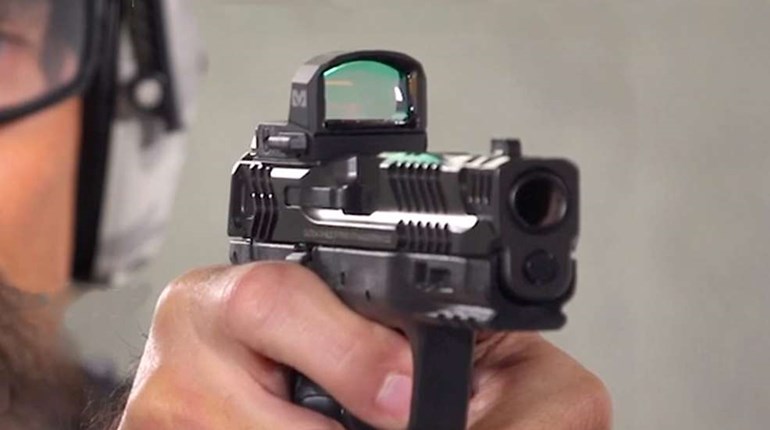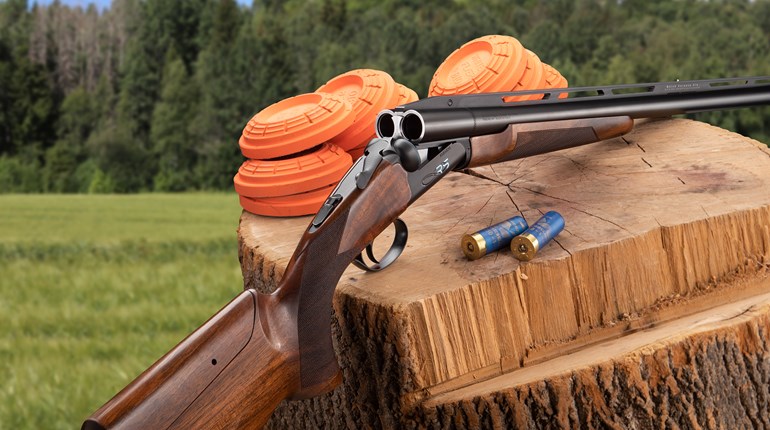** When you buy products through the links on our site, we may earn a commission that supports NRA's mission to protect, preserve and defend the Second Amendment. **
LMS Defense came to NRA headquarters and demonstrated its unique and practical Zero Distance Pistol Course, a class designed to help citizens who carry concealed deal with the realities of self-defense.
The class began with a question: What is Zero Distance? Instructor Troy Price, a 30-year veteran of the United States Marine Corps, presented evidence gathered from FBI studies on situations where law enforcement officers are killed or wounded every year. In this data, he finds a number of conclusions that led him to develop what he calls the "90-percent rule." The rule states that 90 percent of person-on-person crimes committed in an average year occur inside of 10 feet.
The numbers get interesting when that statistic is compared to standards in modern-day firearms training. Many training classes focus on the "21-foot rule," the idea that an attacker can close a distance of 21 feet within 1.5 seconds. Thus, 1.5 seconds is generally taken to be the minimum response time for an armed citizen facing a threat. According to Price, though, that's generous.
"If you accept the fact that a person can cover 21 feet in 1.5 seconds, we have to accept that an individual committing a violent crime will close the distance from 10 feet in less than three-quarters of a second," Price said.
This reality led Price to develop the Zero Distance Pistol course, designed to develop techniques that make shooters more efficient by incorporating intuitive and simple strategies to improve students' effective-response time. To facilitate the development of these skills, shooters never fire at a distance of more than 9 feet during the course.
The class focuses on five absolute principles. The first principle, discussed in the video above, is the importance of the trigger press and how imperative good trigger control is to putting effective rounds on target. The second principle is speed. In a zero-distance defensive situation, Price contends, speed is a higher priority than accuracy, given that inside of 10 feet, all rounds should impact on an attacker-size target—but those rounds must be effective. This rolls into the third principle of "effective accuracy." In zero-distance engagements, shots must be taken that either prevent the threat from continuing the incident or create time, space and distance for the shooter. Space and distance are not the same thing: Space is room to maneuver within a zero-distance engagement zone, such as the ability to block an incoming punch. Distance, on the other hand, is separation from the zero-distance zone allowing you to exit the area or more effectively engage an attacker.
In order to economize time, Price rolls out the fourth principle, which encourages the use of intuitive and simple movements during drawing and firing. Finally, another essential component of the course is the focus on clearing a handgun from concealment. The combination of these principles, in tandem with demonstrations and one-on-one instruction with Price and instructor Jim Carter, allowed NRA employees to progress from a traditional 1.5-second draw/fire time to drawing and firing on a target in less than a second. Every student also significantly improved on their ability to put five rounds into a two-inch-wide column in less than 2 seconds, from concealment.
The cost, per person, for a spot in the Zero Distance Pistol Course is $200.
LMS Defense, founded in 2008 by John Chapman, Josh Jackson and Troy Price, offers courses across the country. With enough student demand, the company will send instructors out to teach courses in a designated area. Other courses from LMS Defense include the following:
CCW & Related Courses
Idaho Enhanced CCW
Self Defense for Concealed Carry
Introductory Courses
Pistol Fundamentals
Carbine Fundamentals
Precision Rifle Fundamentals
Knife Defense Fundamentals
Ladies Beginner Pistol Fundamentals
Ladies Beginner Carbine Fundamentals
Shotgun Fundamentals
AK Fundamentals
Basic Courses
Pistol 1
Carbine 1
Precision Rifle 1
Intermediate Courses
Intermediate Pistol Clinic
Low Light Pistol Fundamentals
Pistol CQB Fundamentals
Intermediate Carbine Clinic
Low Light Carbine Fundamentals
Carbine CQB Fundamentals
Home Defense
Concealed Carry Fundamentals
Ladies Defensive Pistol
Pistol 2
Carbine 2
Bad Breath Pistol
Vehicle Tactics
Team Tactics
Practical Scoped Rifle
Evolution of Mindset 1
Advanced Courses
Practical Carbine
Concealed Carry Combatives
CQB Operations
NVG Instructor Course
Low Light CQB
Gunfighting Instructor Development Course
Patrol Counter Ambush
Nighttime Precision Engagement
Practical Long Range Scoped Rifle
Fieldcraft
Medical Courses
Tactical Wounded Care
Care Under Fire
The class began with a question: What is Zero Distance? Instructor Troy Price, a 30-year veteran of the United States Marine Corps, presented evidence gathered from FBI studies on situations where law enforcement officers are killed or wounded every year. In this data, he finds a number of conclusions that led him to develop what he calls the "90-percent rule." The rule states that 90 percent of person-on-person crimes committed in an average year occur inside of 10 feet.
The numbers get interesting when that statistic is compared to standards in modern-day firearms training. Many training classes focus on the "21-foot rule," the idea that an attacker can close a distance of 21 feet within 1.5 seconds. Thus, 1.5 seconds is generally taken to be the minimum response time for an armed citizen facing a threat. According to Price, though, that's generous.
"If you accept the fact that a person can cover 21 feet in 1.5 seconds, we have to accept that an individual committing a violent crime will close the distance from 10 feet in less than three-quarters of a second," Price said.
This reality led Price to develop the Zero Distance Pistol course, designed to develop techniques that make shooters more efficient by incorporating intuitive and simple strategies to improve students' effective-response time. To facilitate the development of these skills, shooters never fire at a distance of more than 9 feet during the course.
The class focuses on five absolute principles. The first principle, discussed in the video above, is the importance of the trigger press and how imperative good trigger control is to putting effective rounds on target. The second principle is speed. In a zero-distance defensive situation, Price contends, speed is a higher priority than accuracy, given that inside of 10 feet, all rounds should impact on an attacker-size target—but those rounds must be effective. This rolls into the third principle of "effective accuracy." In zero-distance engagements, shots must be taken that either prevent the threat from continuing the incident or create time, space and distance for the shooter. Space and distance are not the same thing: Space is room to maneuver within a zero-distance engagement zone, such as the ability to block an incoming punch. Distance, on the other hand, is separation from the zero-distance zone allowing you to exit the area or more effectively engage an attacker.
In order to economize time, Price rolls out the fourth principle, which encourages the use of intuitive and simple movements during drawing and firing. Finally, another essential component of the course is the focus on clearing a handgun from concealment. The combination of these principles, in tandem with demonstrations and one-on-one instruction with Price and instructor Jim Carter, allowed NRA employees to progress from a traditional 1.5-second draw/fire time to drawing and firing on a target in less than a second. Every student also significantly improved on their ability to put five rounds into a two-inch-wide column in less than 2 seconds, from concealment.
The cost, per person, for a spot in the Zero Distance Pistol Course is $200.
LMS Defense, founded in 2008 by John Chapman, Josh Jackson and Troy Price, offers courses across the country. With enough student demand, the company will send instructors out to teach courses in a designated area. Other courses from LMS Defense include the following:
CCW & Related Courses
Idaho Enhanced CCW
Self Defense for Concealed Carry
Introductory Courses
Pistol Fundamentals
Carbine Fundamentals
Precision Rifle Fundamentals
Knife Defense Fundamentals
Ladies Beginner Pistol Fundamentals
Ladies Beginner Carbine Fundamentals
Shotgun Fundamentals
AK Fundamentals
Basic Courses
Pistol 1
Carbine 1
Precision Rifle 1
Intermediate Courses
Intermediate Pistol Clinic
Low Light Pistol Fundamentals
Pistol CQB Fundamentals
Intermediate Carbine Clinic
Low Light Carbine Fundamentals
Carbine CQB Fundamentals
Home Defense
Concealed Carry Fundamentals
Ladies Defensive Pistol
Pistol 2
Carbine 2
Bad Breath Pistol
Vehicle Tactics
Team Tactics
Practical Scoped Rifle
Evolution of Mindset 1
Advanced Courses
Practical Carbine
Concealed Carry Combatives
CQB Operations
NVG Instructor Course
Low Light CQB
Gunfighting Instructor Development Course
Patrol Counter Ambush
Nighttime Precision Engagement
Practical Long Range Scoped Rifle
Fieldcraft
Medical Courses
Tactical Wounded Care
Care Under Fire
























